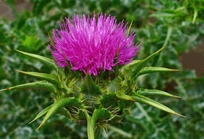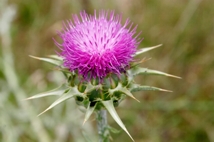| Perennial / Desiduous Trees / Purple MILK THISTLE Silybum Marianum |
|
|
|
|
| |
|
Plant name - Milk Thistle
|

|
|
 |
|
 |
| Common name - Silybum Marianum
|
| Plant type - Vegetable - herb |
| Vegetation type -
Perennial |
| Growth rate - fast |
| Leaf / Flower color
- Green / purple |
| Other names - Silybum Marianum |
| |
| Description : |
The plants typically germinate in the autumn after the first rains and exist as rosettes throughout the first year, forming a stout, fleshy taproot that may extend down 30 cm or more for a food reserve. The leaves are 10–50 cm wide, are alternate and spiny, often covered with white woolly hairs and with the lower surface more densely covered than the upper. The leaves are deeply lobed with long, stiff spines along the margins.
Fine hairs give the plant a greyish appearance. The massive main stem may be 10 cm wide at the base, and is branched in the upper part. Each stem shows a vertical row of broad, spiny wings (conspicuous ribbon-like leafy material), typically 2–3 cm wide, extending to the base of the flower head. The flowers are globe shaped, 2–6 cm in diameter, from dark pink to lavender, and are produced in the summer.
The flower buds form first at the tip of the stem and later at the tip of the axillary branches. They appear singly or in groups of two or three on branch tips.
.
|
| |
| Growing Instructions : |
* Plant the seeds indoors. Push the seeds just below the surface at a depth of about three millimeters. Plant biennial varieties of milk thistle in early summer and annual varieties in early spring. Keep the seeds at a temperature of 12 to 15 degrees Celsius for three weeks so they'll germinate.
* Select a permanent site in your garden for milk thistle. It can grow in partial shade, but will need at least 7 to 8 hours of direct sunlight each day to go to seed. Milk thistles can generally tolerate a wide range of soil types and the ideal soil is midway between sand and loam.
* Plant milk thistle outside. These plants are quite hardy and can also be planted outside directly from seed. Plant biennials outside in early summer and annuals after the last frost.
* Maintain milk thistle. These plants can tolerate both wet and dry soil, so you don't generally need to water them. Prune any dead flower heads before the flowers release their seed. This practice is known as "deadheading" and will encourage the milk thistle to produce more flowers. Remove any unwanted milk thistle plants.
|
| |
|
|
|
|
|
